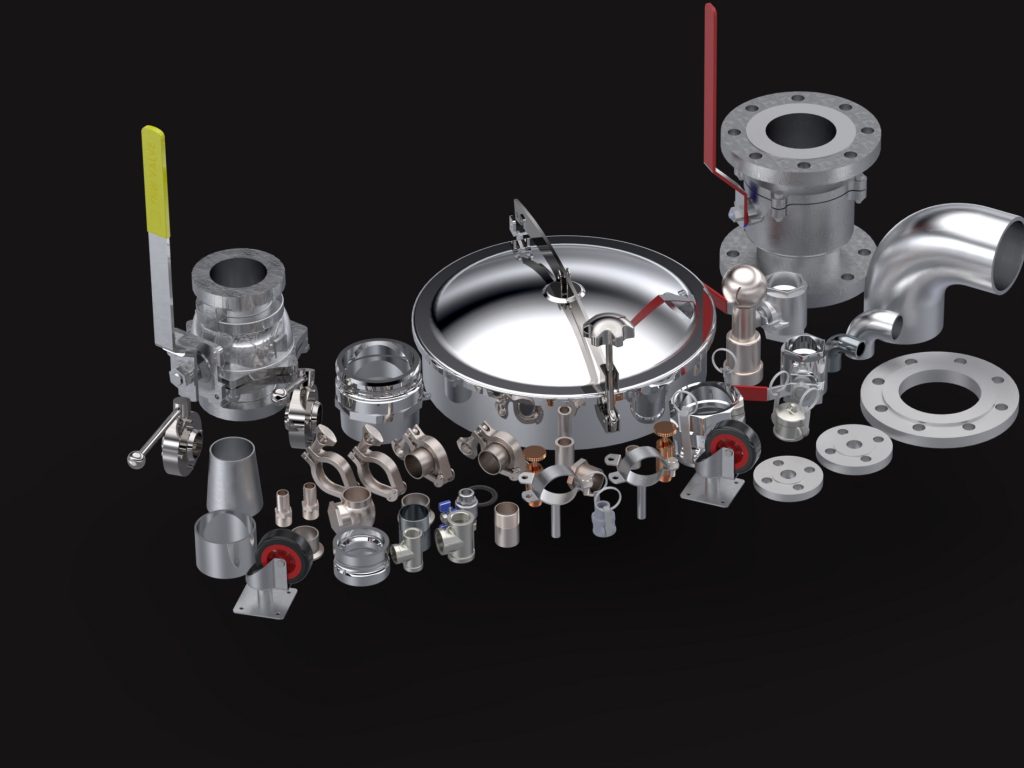What are Stainless Fittings?
Stainless fittings are parts made of stainless steel used to provide connections in piping systems. They are frequently preferred in sectors such as chemical, food, pharmaceutical, and petroleum.
Thanks to their high corrosion resistance and long-lasting structures, stainless fittings are an ideal solution for transporting water, gas, and liquids.
Types of Stainless Fittings
Stainless fittings are classified according to different connection methods and purposes of use. Here are the most common types of stainless fittings:
1. Welded Stainless Fittings
- They enable stainless steel pipes to be connected to each other by welding.
- They offer a more robust and leak-proof connection.
- They are used for transitions between different diameters.
2️.Threaded Stainless Fittings
- They have a screwed connection system.
- They are easy to assemble and disassemble.
- They are commonly used in small-diameter pipe systems.
3️.Flanged Stainless Fittings
- They are used in large-diameter pipe systems.
- They are assembled using a bolted connection method.
4️.Clamped (Clamp) Stainless Fittings
- They are used in hygienic plumbing systems.
- They are easy to remove and install.
5️.Elbow and Tee Stainless Fittings
- They are used to change the direction of pipes.
- They are available in 45° and 90° angles.
Stainless Steel Fittings Production Process
The production of stainless fittings consists of several meticulously performed steps:
1️.Raw Material Selection: Stainless steel (304, 316, etc.) is determined.
2️.Cutting: The steel is cut to the appropriate dimensions.
3️.Forming: It is shaped by pressing or forging.
4️.Heat Treatment: The material is hardened and its durability is increased.
5️.Surface Treatment: Polished or matte surface coatings are applied.
6️.Testing and Certification: It passes quality control tests.
Application Areas of Stainless Fittings
The sectors where stainless fittings are commonly used are as follows:
- Food Industry: Preferred for being hygienic and durable.
- Chemical and Petrochemical: Resistant to acids and chemicals.
- Maritime: Offers high corrosion resistance against saltwater.
- Aviation and Defense: Resistant to high pressure and temperature.
- Water Treatment: Used safely due to the hygienic nature of stainless steel.
Stainless Steel Material Grades
The most common material grades from which stainless fittings are produced are:
|
Material Type |
Properties |
|
304 Stainless Steel |
Suitable for general use, has a moderate level of corrosion resistance. |
|
316 Stainless Steel |
Highly resistant to seawater and chemicals. |
|
321 Stainless Steel |
Used for high-temperature applications. |
|
904L Stainless Steel |
Preferred in applications requiring extreme corrosion resistance. |
Things to Consider When Choosing Stainless Fittings
- Purpose of Use: The material and type should be selected according to the sector.
- Pressure and Temperature Resistance: It must comply with operating conditions.
- Connection Type: Welded, threaded, or flanged type should be determined according to the need.
- Quality Certificates: Compliance with standards like ISO, ASTM should be checked.
Frequently Asked Questions (FAQs) about Stainless Fittings
1️.Do stainless fittings rust?
No, high-quality stainless steel fittings are resistant to corrosion. However, improper maintenance or the use of low-quality material can lead to rust.
2️.How are stainless fittings prices determined?
Prices vary depending on the steel grade, diameter, production method, and market conditions.
3️.What temperatures can stainless fittings withstand?
304 stainless steel can withstand up to 870°C, while 316 stainless steel can withstand up to 925°C.
4️.Where can I buy stainless fittings?
They should be purchased from reliable industrial suppliers and manufacturers. Certified products should be preferred.
5️.Should I choose threaded or welded fittings?
Threaded fittings should be preferred for low-pressure systems, while welded fittings should be preferred for high-pressure systems and those requiring a leak-proof seal.
6️.How are stainless fittings maintained?
Long-term use can be ensured with regular cleaning and chemical resistance tests.
Stainless fittings, offer a reliable solution for industrial and domestic applications with their durability and long-lasting structure. When used with quality material selection and the correct connection method, they exhibit excellent performance in plumbing systems.


